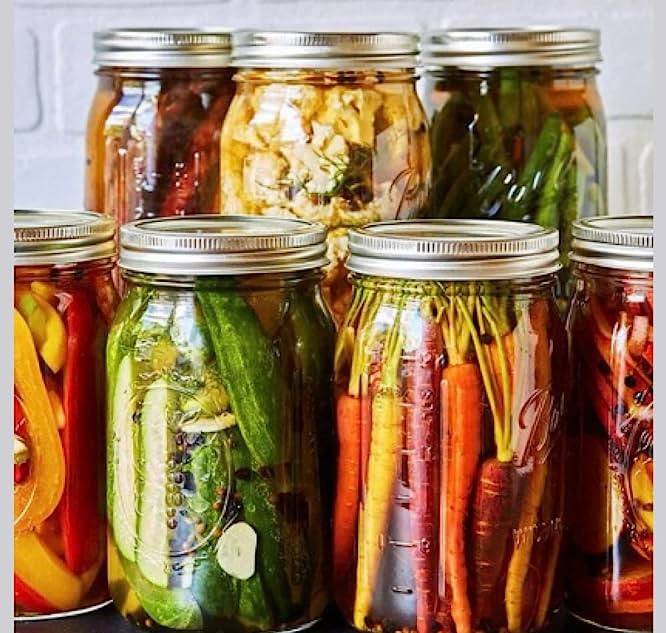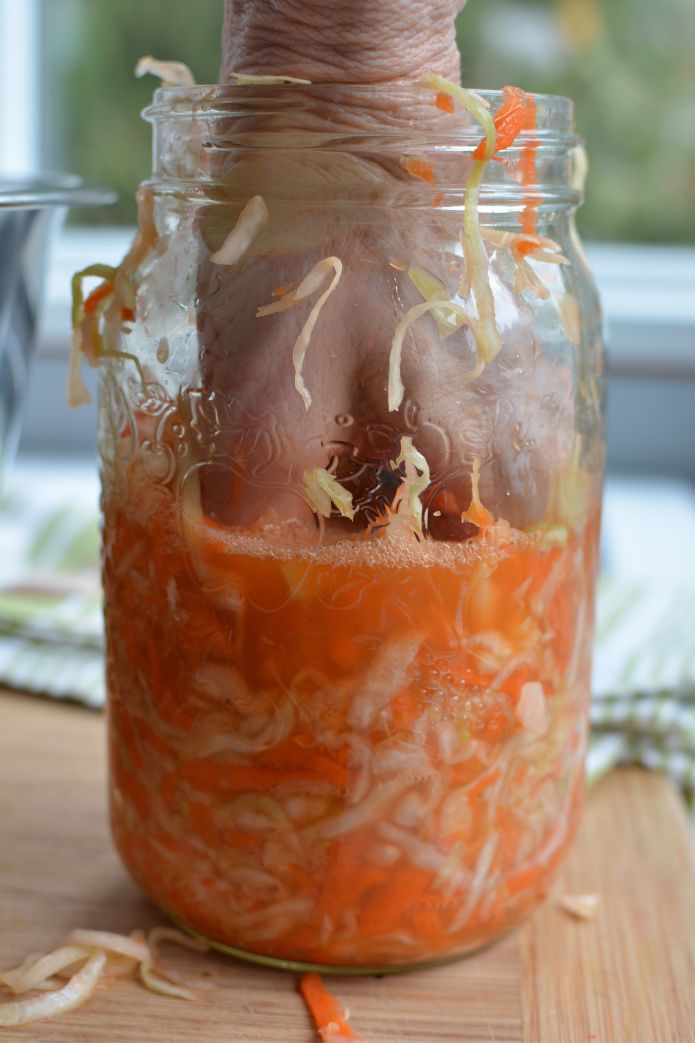Fermentation is an age-old process that has been used for centuries to preserve food and create new flavours.
It’s a natural process that occurs when microorganisms like bacteria, yeast, and fungi break down carbohydrates in food, producing acid or alcohol.
If you’re interested in learning more about fermentation, you’ve come to the right place!
In this beginner’s guide, we’ll explore everything you need to know to get started with fermenting your own foods at home.

What is Fermentation and Why is it Important?
Fermentation is a process that preserves food and enhances its nutritional value.
It makes food easier to digest and increases the bioavailability of nutrients.
This means that our bodies can absorb these nutrients more easily, leading to improved gut health and overall well-being.
The Benefits of Fermentation
Fermentation has many benefits, including:
- Preserving food for longer periods of time
- Enhancing the flavour and texture of food
- Increasing the nutritional value of food
- Improving gut health and digestion
The Fermentation Process
The fermentation process involves the use of microorganisms, such as bacteria or yeast, to break down sugars and other compounds in food.
This produces lactic acid, alcohol, or other byproducts that help preserve the food and give it a unique flavour and texture.
Fermentation is a natural process that has been used for centuries to preserve food and improve its nutritional value.
Common fermented foods include:
Fermented foods are a great source of probiotics, which are beneficial bacteria that help to improve gut health and boost the immune system.
The History of Fermentation in Human Culture

For thousands of years, humans have been using fermentation to preserve food.
The ancient Egyptians used fermentation to make beer, while the Chinese were making soy sauce and tofu over 2000 years ago.
Many traditional cultures still use fermentation today, such as the Koreans who make kimchi and the Germans who brew beer.
The Science of Fermentation
Fermentation is a process where microorganisms, such as yeast or bacteria, break down sugars in food to produce alcohol, lactic acid, or other compounds.
This process not only preserves food but also enhances its flavour and nutritional value.
Fermentation can be used to make a variety of foods, including bread, cheese, yoghurt, and pickles.
The Health Benefits of Fermented Foods
Fermented foods are rich in probiotics, which are beneficial bacteria that live in our gut and help improve digestion and boost the immune system.
Studies have also shown that consuming fermented foods can help reduce inflammation, lower cholesterol levels, and even improve mental health.
The Future of Fermentation
Fermentation is becoming increasingly popular as people seek out healthier and more sustainable food options.
Many companies are now producing fermented foods and drinks, such as kombucha and kefir, and there is a growing interest in home fermentation as well.
As we continue to learn more about the health benefits of fermented foods, it is likely that fermentation will play an even bigger role in our diets in the future.
The Scientific Process of Fermentation
The science behind fermentation involves microorganisms breaking down sugars in food into lactic acid, acetic acid, or alcohol.
This process creates an acidic environment, which prevents harmful bacteria from growing and helps preserve the food.
The Role of Microorganisms in Fermentation
Microorganisms such as bacteria and yeast are responsible for the fermentation process.
These microorganisms consume the sugars in the food and produce various byproducts such as lactic acid, acetic acid, or alcohol.
During fermentation, the microorganisms produce enzymes that break down the sugars in the food, which results in the production of various byproducts.
The Benefits of Fermentation
Fermentation has been used for centuries to preserve food and enhance its flavour.
The process of fermentation not only preserves the food but also increases its nutritional value by producing beneficial bacteria and enzymes.
Fermented foods such as kimchi, sauerkraut, and kefir are rich in probiotics, which are beneficial for gut health and digestion.
The Different Types of Fermentation
There are two main types of fermentation: lactic acid fermentation and alcoholic fermentation.
Lactic acid fermentation is used to produce foods such as yoghurt, sauerkraut, and pickles, while alcoholic fermentation is used to produce beer, wine, and other alcoholic beverages.
During lactic acid fermentation, the microorganisms produce lactic acid, which gives the food its characteristic sour taste. Alcoholic fermentation, on the other hand, produces alcohol as a byproduct.
The Importance of Temperature and pH in Fermentation
The temperature and pH of the environment play a crucial role in the process of fermentation.
Different microorganisms thrive in different temperature and pH ranges, and the wrong conditions can inhibit the growth of beneficial bacteria and promote the growth of harmful bacteria.
For example, the ideal temperature for lactic acid fermentation is between 68-72°F, while the ideal pH range is between 4.0-4.6.
The Benefits of Fermented Foods for Gut Health
Fermented foods are rich in probiotics, which are beneficial bacteria that live in our gut.
These probiotics help to improve digestion, boost immunity, and reduce inflammation in the body.
Examples of Fermented Foods
- Sauerkraut
- Kefir
- Yoghurt
- Kombucha
Consuming fermented foods can also help increase the diversity of gut bacteria, which is important for overall gut health.
Additionally, fermented foods can help improve nutrient absorption and may even have anti-cancer properties.
Probiotics found in fermented foods can help to improve digestion, boost immunity, and reduce inflammation in the body.
How Fermented Foods Help Gut Health
Fermented foods contain live bacteria that can help populate the gut with beneficial microbes.
These microbes can help break down food and absorb nutrients more efficiently, leading to better digestion.
Additionally, the probiotics in fermented foods can help strengthen the immune system and reduce inflammation in the body.
Fermented foods can help to increase the diversity of gut bacteria, improve nutrient absorption, and may even have anti-cancer properties.
Choosing the Right Equipment for Fermentation at Home
To get started with fermentation at home, you’ll need a few basic pieces of equipment.
These include:
Glass Jars or Crocks
When choosing glass jars or crocks for fermentation, make sure they are made of food-grade glass and have a wide mouth for easy access.
Mason jars are a popular choice, but crocks are also great for larger batches.
Airlocks
Airlocks are essential for fermentation as they allow gases to escape while preventing oxygen and other contaminants from entering the jar.
There are many types of airlocks available, including water-sealed and S-shaped airlocks.
Did you know that airlocks can also be used for making homemade wine and beer?
Weights
Weights are used to keep the fermenting food submerged in the brine, preventing mould and other unwanted bacteria from forming on the surface.
Ceramic weights are a popular choice, but you can also use glass weights or even a clean rock.
Fun fact: In Korea, they use a special type of weight called a tsukemono press for fermenting kimchi.
Ingredients for Successful Fermentation
For successful fermentation, it’s important to use the right ingredients.
Cabbage is a great choice for sauerkraut, while cucumbers work well for pickles.
Milk is a key ingredient in yoghurt.
Avoid Preservatives and Additives
When fermenting, it’s important to avoid using ingredients that contain preservatives or additives.
These can interfere with the fermentation process and prevent the growth of beneficial bacteria.
Stick to fresh, natural ingredients for the best results.
Did you know that using iodized salt can also interfere with fermentation? It’s best to use non-iodized salt when fermenting.
Use Quality Ingredients
Using high-quality ingredients is also important for successful fermentation.
Choose fresh, organic produce whenever possible.
This will ensure that you’re getting the best flavour and the most beneficial bacteria.
Did you know that using tap water can also affect fermentation? Chlorine and other chemicals in tap water can interfere with the growth of beneficial bacteria. Use filtered or distilled water instead.
Experiment with Different Ingredients
Don’t be afraid to experiment with different ingredients when fermenting.
You can try using different types of vegetables, fruits, and even grains.
This will help you discover new flavors and textures, and may even lead to the creation of your own unique recipes.
Step by Step Guide to Fermenting Vegetables
Here’s a simple step-by-step guide to fermenting your own vegetables:
Chop and Salt Vegetables
Chop your vegetables into small pieces.
Add salt and massage the vegetables until they release their juices.
Pack Vegetables into a Jar
Pack the vegetables tightly into a glass jar or crock.
Place a weight on top of the vegetables to keep them submerged in the brine.
Ferment Vegetables
Cover the jar with an airlock lid and let it sit at room temperature for several days to several weeks, depending on the desired level of fermentation.
Once the vegetables have reached your desired level of fermentation, you can store them in the refrigerator to slow down the fermentation process.
Did you know that fermented vegetables can last for several months in the refrigerator?
Enjoy Your Fermented Vegetables
Enjoy your fermented vegetables as a side dish, snack, or topping for salads and sandwiches.
The Art of Brewing Kombucha and Kefir
Brewing Kombucha
To brew kombucha, you’ll need a SCOBY (Symbiotic Culture Of Bacteria and Yeast) and tea.
First, brew a pot of tea and let it cool to room temperature.
Then, add the SCOBY and some starter liquid to a jar, and pour in the cooled tea.
Cover the jar with a cloth and let it sit for 7-10 days, until it reaches your desired level of tartness.
Brewing Kefir
For kefir, you’ll need kefir grains and milk.
Add the kefir grains to a jar of milk and cover it with a cloth.
Let it sit at room temperature for 24-48 hours, until it thickens and becomes tangy.
Strain out the kefir grains and store the kefir in the fridge.
Kombucha is a great source of probiotics and antioxidants, while kefir is high in protein and calcium.
Tips for Success
To ensure success, make sure all equipment is clean and sterilised before use.
Use high-quality ingredients and filtered water.
Keep the jars in a warm, dark place away from direct sunlight.
And most importantly, be patient!
The longer you let the drinks ferment, the stronger the flavour will be.
Enjoying Your Brews
Once your kombucha and kefir are ready, you can enjoy them as is or add flavourings like fruit or herbs.
Store them in the fridge to slow down the fermentation process.
And don’t forget to save some starter liquid or grains for your next batch!
- Kombucha and kefir are easy to make at home
- Both drinks require a bit of patience, but the end result is well worth it!
- Experiment with different teas and milks to create unique flavour combinations.
Making Your Own Sourdough Starter and Bread
Sourdough bread is a delicious and nutritious type of fermented food that has become increasingly popular in recent years.
To make your own sourdough starter, you’ll need to mix flour and water together and let it sit for a few days until it becomes bubbly and active.
Once your starter is ready, you can use it to make delicious homemade bread that’s full of flavour and nutrition.
Creating Your Sourdough Starter
To create your sourdough starter, you’ll need to mix equal parts of flour and water together in a jar or container.
Cover the container with a cloth or lid and let it sit at room temperature for a few days.
During this time, the mixture will begin to ferment and become bubbly and active.
You’ll need to feed your starter regularly with more flour and water to keep it alive and active.
Once your starter is active and bubbly, you can use it to make delicious sourdough bread.
Simply mix the starter with more flour, water, and salt to create a dough.
Let the dough rise for a few hours, then bake it in the oven for a delicious homemade loaf of bread.
Tips for Making the Perfect Sourdough Bread
When making sourdough bread, it’s important to use high-quality ingredients and follow the recipe carefully.
Here are a few tips to help you make the perfect loaf:
Use a kitchen scale to measure your ingredients accurately.
Make sure your dough has enough time to rise properly.
This can take anywhere from a few hours to overnight, depending on the recipe.
Use a Dutch oven or other covered pot to bake your bread.
This will help create a crispy crust and a soft, chewy interior.
Experiment with different types of flour and flavourings to create unique and delicious sourdough breads.
Fermenting Dairy Products Like Yoghurt and Cheese
Fermenting dairy products like yoghurt and cheese is a great way to improve their nutritional value and flavour.
Making Yoghurt
To make yoghurt, simply heat milk and add a starter culture.
You can use a store-bought starter or a small amount of plain yoghurt with active cultures.
Keep the mixture at a warm temperature for several hours until it thickens and develops a tangy flavour.
Making Cheese
For cheese, you’ll need to add rennet to the milk to coagulate it.
Rennet is an enzyme that helps the milk solids separate from the liquid.
Once the milk has coagulated, cut the curds and drain off the whey.
Then, let the cheese age for several weeks to develop its flavour and texture.
Did you know that different types of cheese require different ageing times and techniques? For example, cheddar cheese is typically aged for several months, while brie cheese is aged for just a few weeks.
Experiment with different types of milk, cultures, and ageing techniques to create unique and delicious dairy products at home
- Use a store-bought starter or a small amount of plain yoghurt with active cultures to make yoghurt
- Add rennet to the milk to coagulate it when making cheese
- Experiment with different types of milk, cultures, and ageing techniques to create unique and delicious dairy products at home.
Troubleshooting Common Fermentation Problems

Sometimes things don’t go as planned when fermenting foods.
Here are some common problems and how to fix them:
Mould
If you see mould growing on your fermentation, throw it out and start over.
Cloudy Brine
Don’t worry if you see a cloudy brine, it’s normal and won’t affect the taste or safety of your fermented food.
No Bubbles
Make sure your airlock lid is properly sealed and give it more time. Bubbles may not appear for a few days or even a week.
Incorporating Fermented Foods into Your Daily Diet
There are many ways to incorporate fermented foods into your daily diet.
Some ideas include adding sauerkraut to sandwiches or salads, drinking kombucha instead of soda, or using kefir as a base for smoothies.
Fermentation is an ancient art that has stood the test of time.
By incorporating fermented foods into our diets, we can improve our gut health and overall well-being.
With this beginner’s guide, you have all the information you need to get started with fermenting your own foods at home.
Happy fermenting!
